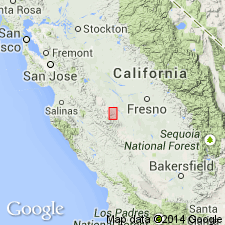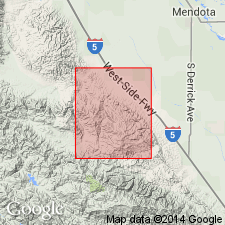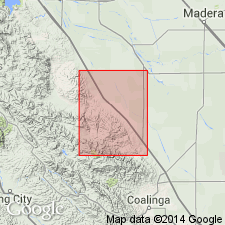
- Usage in publication:
-
- Tumey formation
- Modifications:
-
- Named
- Biostratigraphic dating
- AAPG geologic province:
-
- San Joaquin basin
Summary:
Unit is named the Tumey Formation. Is proposed for the sandstone (800 ft thick) mapped by Anderson and Pack (1915) as faulted "Vaqueros" (just north of Arroyo Ciervo) and to the immediately overlying shales (885 ft thick). The sandstone to be called the Tumey sandstone and the shale the Tumey shale. This sandstone and shale sequence comprises a cartographic unit for a distance of at least 7 mi between Arroyo Ciero and Tumey Gulch. To the southeast the sandstone appears to grade into the shale. A short distance to the northwest of Tumey Gulch it is overlapped by sandstone of Temblor age, containing fossils. The upper 20 ft of the shale member near Arroyo Ciervo contains a zone characterized by a pelecypod commonly called "LEDA" WASHINGTONENSIS Weaver. Some workers in the area report an unconformity about 185 ft below this contact, separating the "LEDA shale" from the main mass of the underlying the Tumey shale. But because of its identical lithologic characteristics and faunal content with the Tumey shale, and because it is not a cartographic unit, the writer classifies it as the upper zone of the Tumey shale. The formation unconformably overlies the Kreyenhagen shale. The strata here named the Tumey formation have been grouped variously with the Vaqueros and the Kreyenhagen or referred tentatively to the Oligocene. (B896)
Source: GNU records (USGS DDS-6; Menlo GNULEX).

- Usage in publication:
-
- Tumey sandstone lentil
- Modifications:
-
- Revised
- Biostratigraphic dating
- AAPG geologic province:
-
- San Joaquin basin
Summary:
Tumey formation is revised (rank reduced) to the Tumey sandstone lentil Kreyenhagen shale. In the Ciervo Hills the Kreyenhagen shale in outcrop contains three members [ascending]: lower Kreyenhagen shale, Tumey sandstone lentil, and Tumey or upper Kreyenhagen shale. Sandstone crops out as a lens about 9 mi long and up to one-half mi wide in shales of the Kreyenhagen. (B1200)
Source: GNU records (USGS DDS-6; Menlo GNULEX).

- Usage in publication:
-
- Tumey Sandstone Lentil*
- Modifications:
-
- Adopted
- AAPG geologic province:
-
- San Joaquin basin
Summary:
Tumey sandstone lentil of Zimmerman (1944) is adopted as a member of the Kreyenhagen Shale. Consists of sandstone, which is locally pebbly. Extends for about 18 km from near Arroyo Ciervo to just north of Tumey Gulch, where it is truncated by the Temblor Formation. Thickness is 800 feet. Age is considered to be late Eocene.
Source: GNU records (USGS DDS-6; Menlo GNULEX).
For more information, please contact Nancy Stamm, Geologic Names Committee Secretary.
Asterisk (*) indicates published by U.S. Geological Survey authors.
"No current usage" (†) implies that a name has been abandoned or has fallen into disuse. Former usage and, if known, replacement name given in parentheses ( ).
Slash (/) indicates name conflicts with nomenclatural guidelines (CSN, 1933; ACSN, 1961, 1970; NACSN, 1983, 2005, 2021). May be explained within brackets ([ ]).

